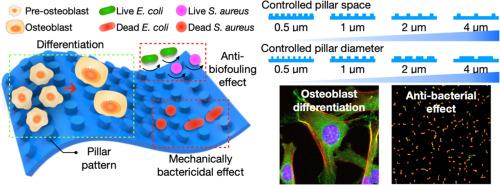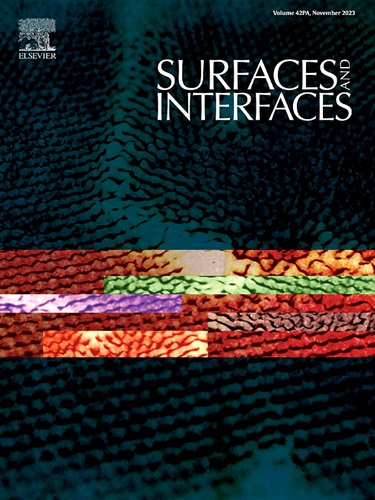聚乙二醇二甲基丙烯酸酯(PEGDMA)多功能柱状图案表面用于前成骨细胞的成骨分化以及对大肠杆菌和金黄色葡萄球菌的抗菌作用
IF 5.7
2区 材料科学
Q2 CHEMISTRY, PHYSICAL
引用次数: 0
摘要
细胞对表面形貌环境非常敏感,而表面形貌环境可诱导细胞形态、细胞骨架和分化发生变化。因此,已知骨植入设备中的地形环境会影响成骨细胞的细胞行为、粘附和分化。此外,为防止手术部位感染(SSIs),还需要具有抗菌特性的骨植入装置。因此,人们需要研究既能促进成骨细胞分化又具有抗菌效果的多功能表面。在这项研究中,我们制作并评估了聚乙二醇二甲基丙烯酸酯(PEGDMA)纳米/微柱状图案表面,以找到具有多功能效果的柱状图案的最佳尺寸特征。结果表明,在高度为 0.5 微米、直径为 1 微米、柱间距为 0.5 微米的柱状图案表面(D1S0.5)和高度为 0.5 微米、直径为 1 微米、柱间距为 1 微米的柱状图案表面(D1S1)上,柱状图案增强了成骨细胞的分化。随后的抗菌效果评估结果表明,优化后的柱状图案表面具有显著的抗菌效果,其中 D1S0.5 柱状图案表面的抗菌效果最好。因此,本研究提出并验证了一种能够促进成骨细胞分化并具有抗菌效果的多功能柱状图案表面。本文章由计算机程序翻译,如有差异,请以英文原文为准。

Poly(ethylene glycol) dimethacrylate (PEGDMA) multi-functional pillar-patterned surface for osteogenic differentiation of pre-osteoblast and anti-bacterial effects to Escherichia coli and Staphylococcus aureus
Cells are sensitive to the surface topographical environment, which can subsequently induce changes in cell morphology, cytoskeleton, and differentiation. Therefore, the topological environment in bone implant devices is known to influence the cell behavior, adhesion, and differentiation of osteoblasts. Furthermore, bone implant devices with anti-bacterial properties could be necessary to prevent surgical site infections (SSIs). Consequently, there is a demand for research into multi-functional surfaces that can facilitate osteoblast differentiation while also possessing an anti-bacterial effect. In this study, we fabricated and assessed the poly(ethylene glycol) dimethacrylate (PEGDMA) nano/micro pillar-patterned surface to find the optimized dimensional characteristics of the pillar pattern for multi-functional effect. Results observed that the pillar pattern enhanced differentiation to osteoblast on the pillar-patterned surface (D1S0.5) having pillars with 0.5 μm height, 1 μm diameter, and 0.5 μm spacing between pillars and pillar-patterned surface (D1S1) having pillars with 0.5 μm height, 1 μm diameter, and 1 μm spacing between pillars. Subsequently, results of evaluating anti-bacterial effect revealed that the optimized pillar-patterned surface exhibited remarkable antibacterial effect, with the D1S0.5 pillar-patterned surface showing the highest antibacterial effect. Consequently, this study proposed and verified a multi-functional pillar-patterned surface capable of promoting osteoblast differentiation with anti-bacterial effects.
求助全文
通过发布文献求助,成功后即可免费获取论文全文。
去求助
来源期刊

Surfaces and Interfaces
Chemistry-General Chemistry
CiteScore
8.50
自引率
6.50%
发文量
753
审稿时长
35 days
期刊介绍:
The aim of the journal is to provide a respectful outlet for ''sound science'' papers in all research areas on surfaces and interfaces. We define sound science papers as papers that describe new and well-executed research, but that do not necessarily provide brand new insights or are merely a description of research results.
Surfaces and Interfaces publishes research papers in all fields of surface science which may not always find the right home on first submission to our Elsevier sister journals (Applied Surface, Surface and Coatings Technology, Thin Solid Films)
 求助内容:
求助内容: 应助结果提醒方式:
应助结果提醒方式:


